Banner photo is of Marty the Millionaire’s at Parliament and Queen in 2016. Photo by K Taylor.
Not that long ago there was a small group of men that most Torontonians were on a first name basis with. There was Sam, Ed and Marty and their stores were as individual as the men themselves. If you live in Toronto, you can probably already picture them; bright, bold, even festive, landmarks that anchored whole neighbourhoods.
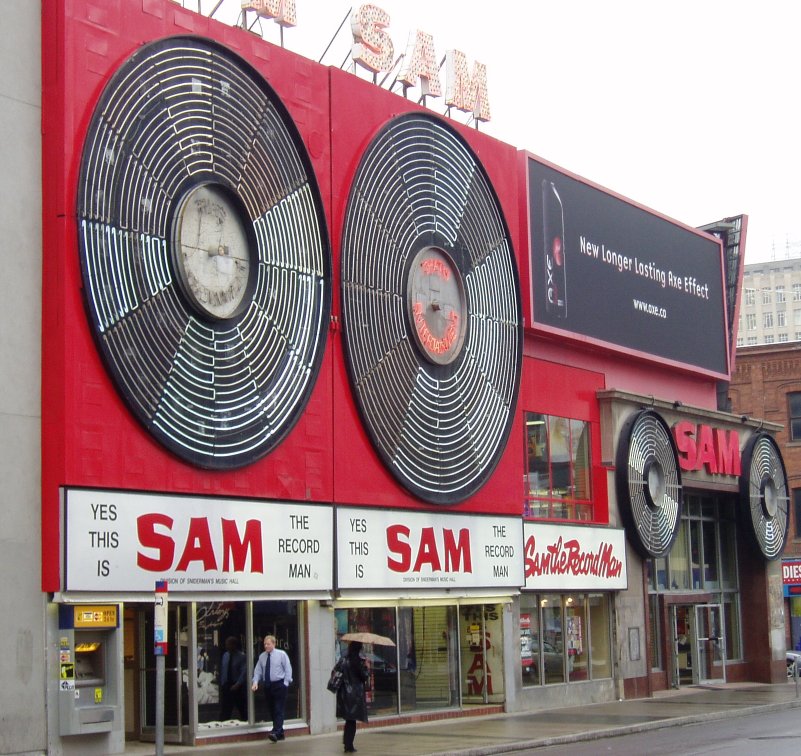
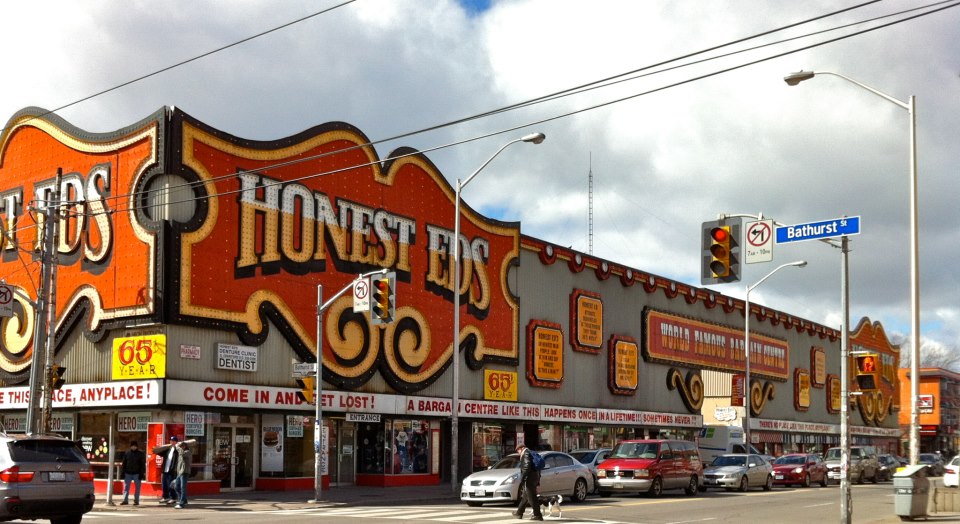
Sadly, all three have passed on. Just as sadly, for the city and its flavour, we’re losing their great mercantile palaces. Sam the Record Man’s massive neon LPs stopped spinning some time ago and Honest Ed’s labyrinthine circus tent is being prepared for the big sleep. By way of bulldozer. I think I’d just begun to accept that news when, just over a year ago, I was startled to see the large display windows of Marty the Millionaire’s papered over and a simple sign announcing its closing. Soon after, the store was emptied and the pink neon sign turned off.
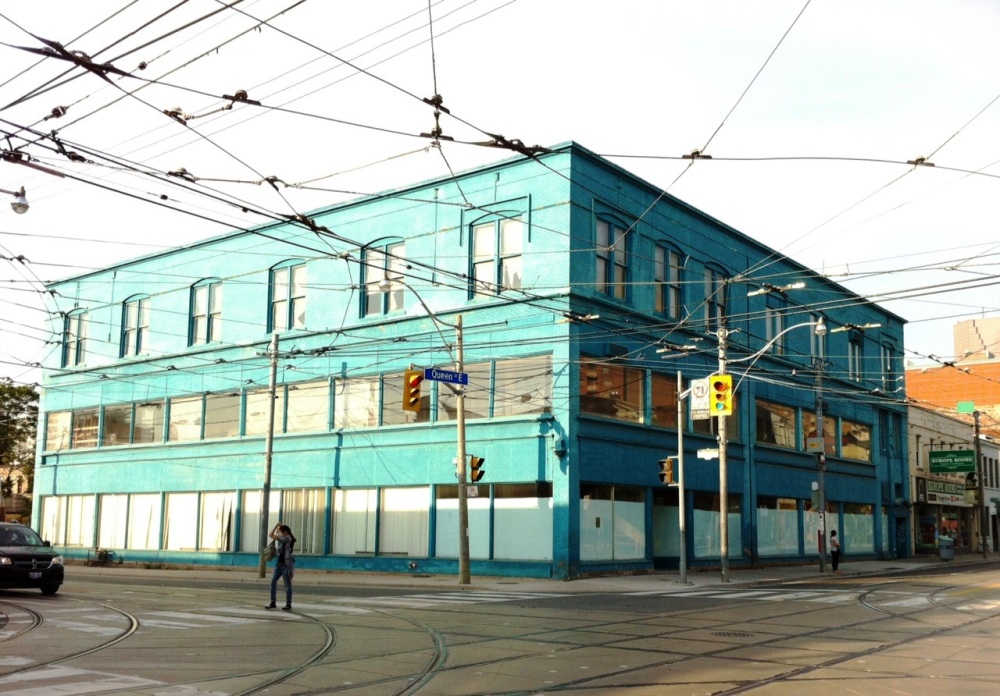
Much as I’ll miss it and its fascinating array of unique furniture – it was the kind of place that had enormous, gorgeous pieces that would be at home in the Vanderbilt mansion, but also gaudy chairs shaped like stiletto heels – Marty Nefsky was but one of many interesting characters to call the SW corner of Parliament and Queen home.
Parliament was named for, yup, the Parliament buildings which once stood on the South side of Palace St (Front St as we know it today) at the foot of Berkeley St. For whatever reason, the name was given to this stretch though the buildings had long since gone. Like so many early structures in York/Toronto they’d proven irresistible to flame. Though, to be fair, some American visitors in 1813 are credited with starting the first blaze. It took the town a while to rebuild them but the buildings were eventually replaced in 1820 – only to burn down again four years later. However, according to this entry from the 1833 City Directory they were not completely erased from the landscape:

At the time, Parliament was the furthest street east of the city, south of Queen, and there were no homes on it whatsoever. But soon after, an Irishman named Beatty would arrive in Toronto and help change that.
When he first arrived, just after the Rebellion of ’37, Adam Beatty opened a provision shop on Queen St. W, selling grain and produce. He was hardly the first or only guy to be running such a business, but still managed to make a heap of money quickly. In 1850, flush with green (and I don’t mean produce), he saw potential in the sparsely populated area around Parliament and Queen St. E. and decided to buy up some land. He built an inn on the SW corner and named it the Enniskillen Hotel; an apparent ode to his birthplace in County Fermanagh, Ireland.
Throughout the 1850s, Beatty’s corner lot was alternately listed as an inn, hotel and tavern. But really, at the time, they all amounted to the same thing: liquor, a stable and a few rooms for travelers or the soused to sleep off a late night. I’ve mentioned Toronto’s reputation as a hard drinking town elsewhere, so I’ll just say that with the combination of its location at the eastern reaches of town and not a whole lot else going on, I’d imagine Beatty did a pretty a good business. It probably also didn’t hurt that Beatty belonged to that most powerful and fearsome of Toronto’s gangs, uh I mean groups, the Orangemen.
The Orange Order was a tremendous force to be reckoned with in Upper Canada and most certainly in Toronto where the Grand Orange Order of British America was established in 1830. Well represented across all classes, from labourers to shop keepers to municipal politicians, Orangemen dominated the city. They had a finger (if not a fist) in every official office and judges’ quarters and they were the militia. Like other fraternal societies, they organized activities and benefits within their community and made sure their members made good business connections. But what they really came to be known for was a good, old-fashioned riot. Lord, how they must’ve loved them. Between 1839 and 1866, the Orangemen were involved in 29 of them. Perhaps the only thing they loved to do more was have a parade. But then, as many of these were conducted through Catholic neighbourhoods, they often became riots – so win-win, I guess.
Not that this all went unchallenged. In 1836 (quite early in the Orange reign) Marshall S Bidwell, member of the Legislative Assembly, submitted this request to Sir Francis Bond Head, asking that the public processions be prohibited:

The request was, of course, turned down. Coincidentally, it was the last year that Bidwell served as part of the Legislative Assembly. A year later he was forced out of the province, apparently by Bond Head, for lobbying for responsible government and acting as speaker of the Reform assembly.
All of which is a long way of saying that our Adam Beatty was in with some pretty heavy hitters. And he became one himself, serving as both an assessor and alderman for a number of years, as well as being a pretty serious landowner – because it wasn’t long before he owned the entire block where he first built his inn.
No sooner had the Enniskillen Hotel opened for business than houses began to crop up on the block, and from the very first, in 1850, Adam Beatty had a neighbour directly to the South on Parliament. The tenant’s name was Robert Clindinning and he would stay for a long time – outliving both the hotel and Beatty himself.
Clindinning, like Beatty, was born in Ireland and came to Canada with his family in 1819 when he was just four years old. As a teenager in Kingston, ON, he worked in the newspaper office of the Courier for six years and became a printer by trade. From there he bounced from one newspaper to another – the Palladium, the Star, the Upper Canada Gazette and the Church – until he landed in Toronto in 1843, working as one of just three printers at George Brown’s new paper the Banner. When the Banner merged with the Globe a year later, Clindinning stayed on. It was during this time that he became the recording secretary of the York Typographical Society, a printers’ union. A year later he would become its president. When George Brown and the union went head to head over wage rates, Brown offered Clindinning the amount set by the group but only if Clindinning quit the union. Clindinning refused, saying “I will not desert the Society” and so lost his job.
After so much movement in Ontario and the bitter fallout with Brown, Clindinning perhaps thought a change of scenery (and country) was in order. He headed to New York and bought his own printing-office. I don’t know if he couldn’t make a go of it on his own or if he was just homesick, but within a year he sold the office to Robert Smiley, founder of the Hamilton Spectator, and returned to Toronto – and, surprisingly, the Globe. His second-go-around with the Globe was shorter and after a year he was on the move again. He finally landed at the Leader where he’d stay until 1878.
Aside from his important role in Toronto’s early labour movement, Clindinning is also remarkable (at least to me) for having been in the audience of several public executions. Of course, we all know these things used to happen and history – or at least the movies – tells us that the hangings drew big crowds. Sure, amusements of the time were few and far between and all that but still … it’s hard to imagine wanting to be party to such a thing. I mean, I don’t think I could stomach it once – let alone multiple times. But not so, our Clindinning. He was there for the execution of a woman named Julia Murdock, a servant who poisoned her mistress with arsenic, as well as that of a farmer who ‘roasted’ his child. Perhaps harder for Clindinning to watch were the hangings of two Reformers, Samuel Lount and Peter Matthews, who were executed for their roles in the Upper Canada Rebellion of ’37. Described as a strong Reformer himself I expect, on this occasion, Clindinning was there in solidarity with the doomed men.
For being on opposite sides of the fence, politically, Adam Beatty and Robert Clindinning, certainly didn’t seem to mind sharing one, physically. Of course, I can’t say whether or not they were chummy, but for 38 years they were neighbours. When Adam Beatty died in 1888, Robert Clindinning moved out of the neighbourhood.
Beatty’s block continued on, unchanged much, until 1907 when a fellow named J Francis Brown came looking for a new home for his Home Furniture and Carpet Co.
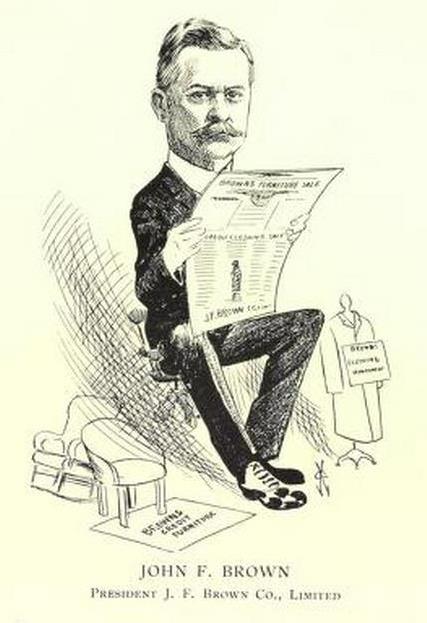
An American by birth, he’d begun his Canadian career in 1885, flying under his own flag with the J. F. Brown Co. He began business working out of Room 18 in the Commercial Building at Yonge and Colborne Sts. From there he moved to the SE corner of Yonge and Queen in 1892, across the street from where Robert Simpson was doing a brisk business.

Soon enough he was doing quite well himself and found he’d outgrown his small digs at Yonge and Queen. He had a terrific Chicago-style building erected at 193 Yonge in 1903, but soon felt the need for another. And so, in 1907, the pokey little buildings on the SW side of Parliament and Queen were razed and replaced with what, then, must’ve been an astoundingly modern structure.
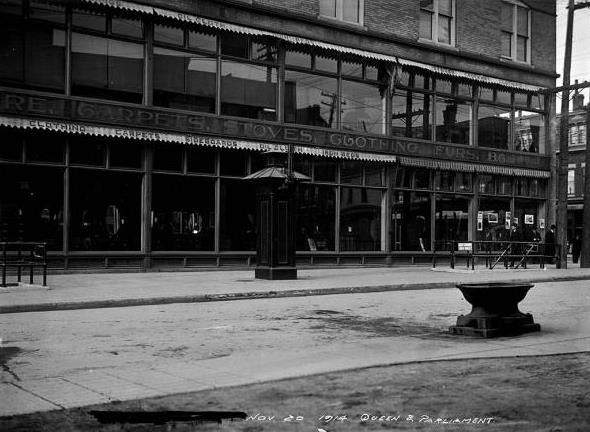
The new site was designed in the same Chicago-style as Brown’s earlier building – and truly, both have much in common with Robert Simpson’s marvel at Yonge and Queen.
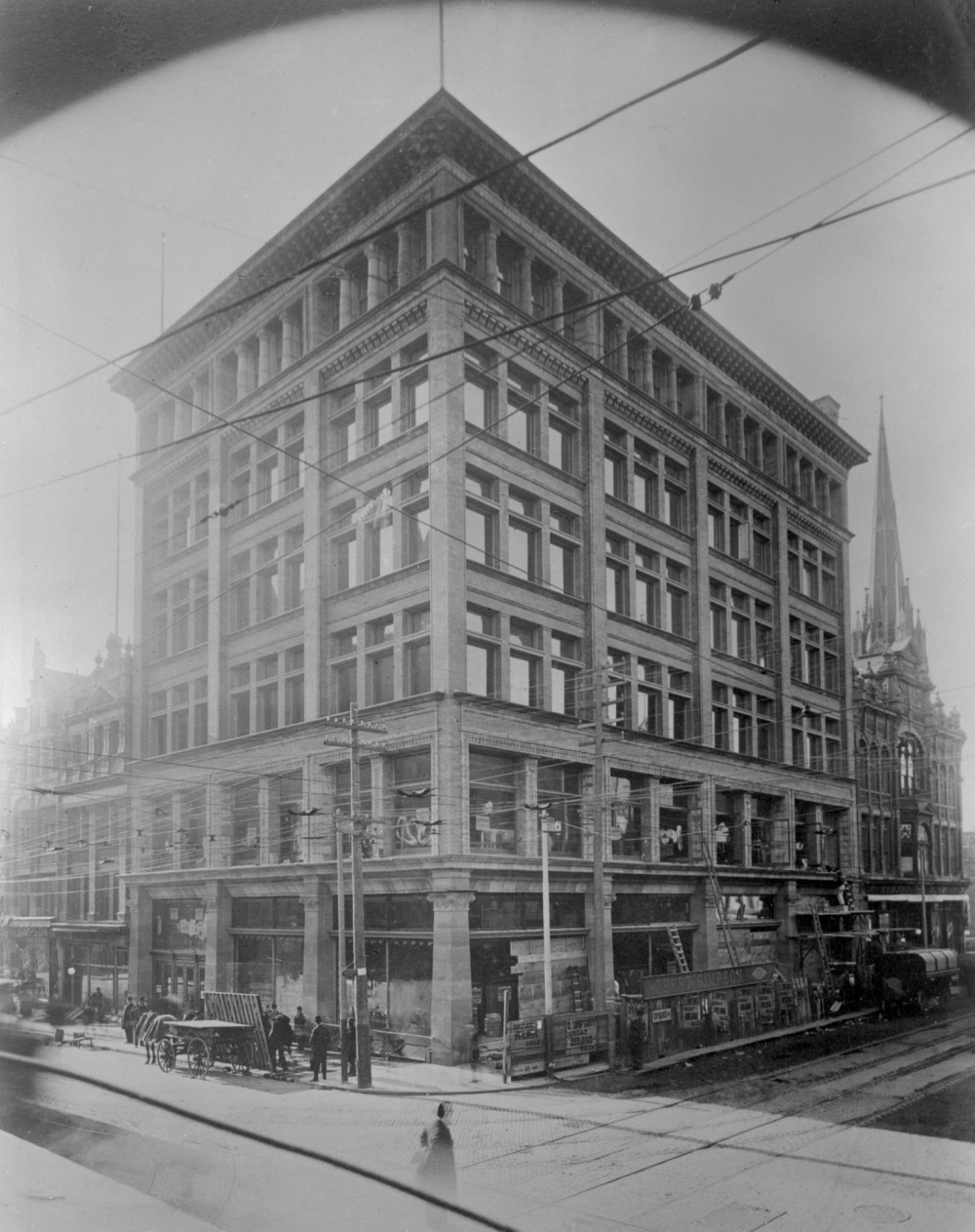
It appears that J. Francis Brown died sometime in 1925-26, but the Home Furniture Carpet Co carried on. Under its new president, J. Franklin Brown (how’s that for confusing), the building was extended west along Queen, more than doubling its original size. And it wasn’t all just more floorspace for furniture – the new addition also housed a bowling alley. Originally called the Home Bowling Club, it was later known as the Riverdale Bowling Alleys. … Say what you want about the past and its lack of conveniences, but at least there were bowling alleys downtown.
And so the building remained (minus a cornice, and plus some covered windows) until 1978 when Marty Nefsky and his millions moved in. Aside from painting it blue, it’s really not much changed. It’s certainly just as I remember it all my life and on one occasion in particular. When I was a teenager I was once stranded by a broken down streetcar and sat on the sill of Marty’s waiting for it to be repaired or dragged away to clear the tracks for another. As these memories always seem to go, it was a very hot summer night and sitting alongside me was a guy I thought made the world go round. Now, I don’t want to toot my own horn here, but I’m pretty sure he was half-aware I existed. The streetcar was eventually brought back to life and we, and a handful of others, continued on our way. A nothing half hour to some, but a gift to a teenage girl.
I’m happy to say, for the J. F. Browns’, Marty’s and my own sake, that this great blue beauty has been bought by Free the Children and is being restored as I write this. It will be used as their headquarters and Global Learning Centre – and, if there is any justice in this world, a bowling alley.
I “lol”ed at your comments about the Orangemen and their parade/riots. And that farmer who roasted his child?! Ick. I don’t support capital punishment, and I certainly wouldn’t want to watch an execution (I can’t even watch that video of the poor elephant that asshole Edison electrocuted, just thinking about it makes me sick), but I guess some people had it coming more than others, if you know what I mean. But I dig Honest Ed’s building, shame it’s being knocked down. I guess the masses don’t love a pun as much as I do.
LikeLiked by 1 person
Yeah, damn that feckin’ Edison. So sickening.
It’s too bad you won’t get a chance to see Honest Ed’s – you would have had a field day there. It’s so weird and kitschy and wonderful. One of his other signs says “Come in and get lost” and you really could. There have been times I’ve almost panicked because I’ve gotten so turned around in there. Ah well. Now that he’s gone, his son is knocking it down to build a massive condo.
LikeLiked by 1 person
Funny I never went in to Marty’s. Always looked in with wonder. I passed by it enough lube around there and frequent that area for business a lot. K Taylor you do an outstanding job on your blogs. Really appreciate them.
LikeLiked by 1 person
Thank you so much, that means a lot to me. I love yours – you do great and important work.
LikeLike